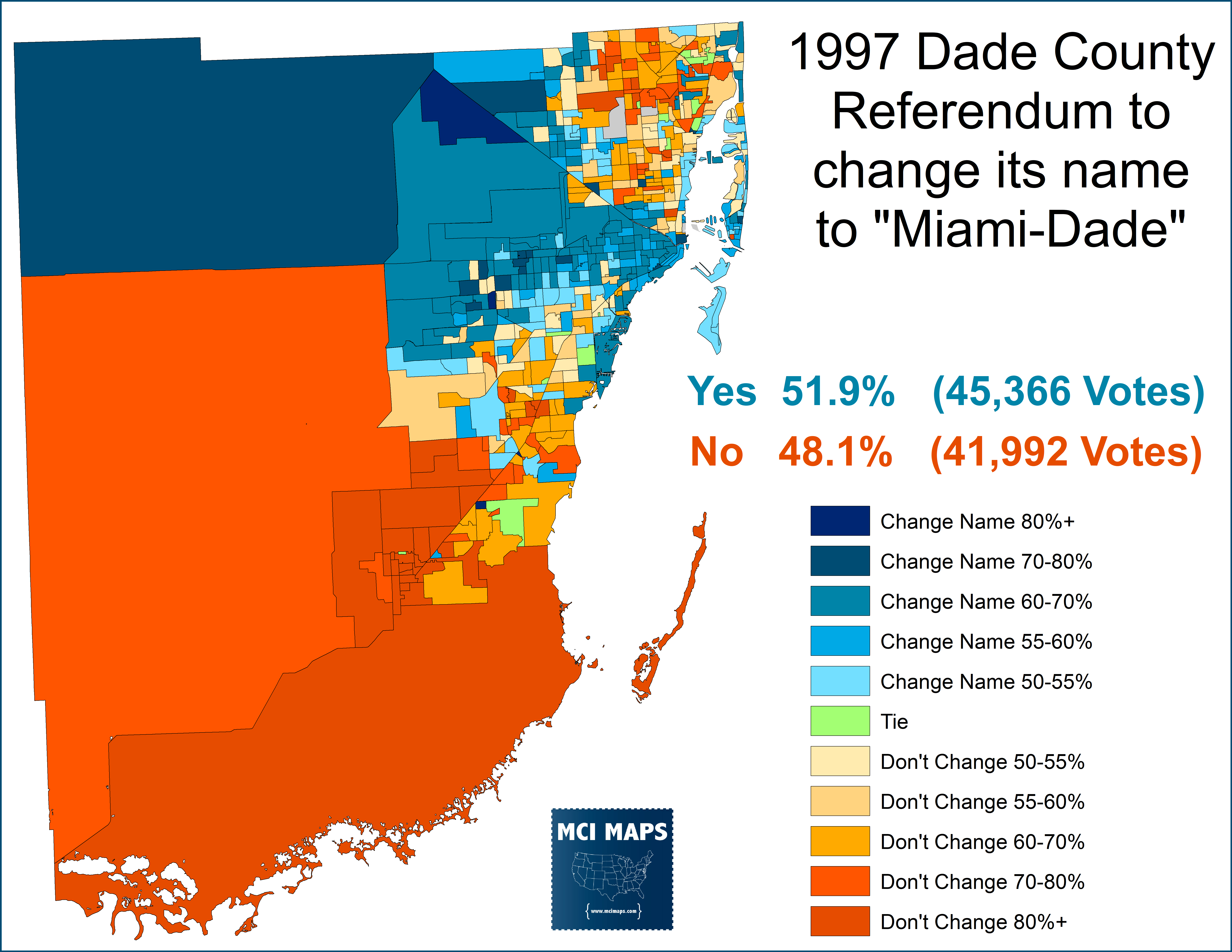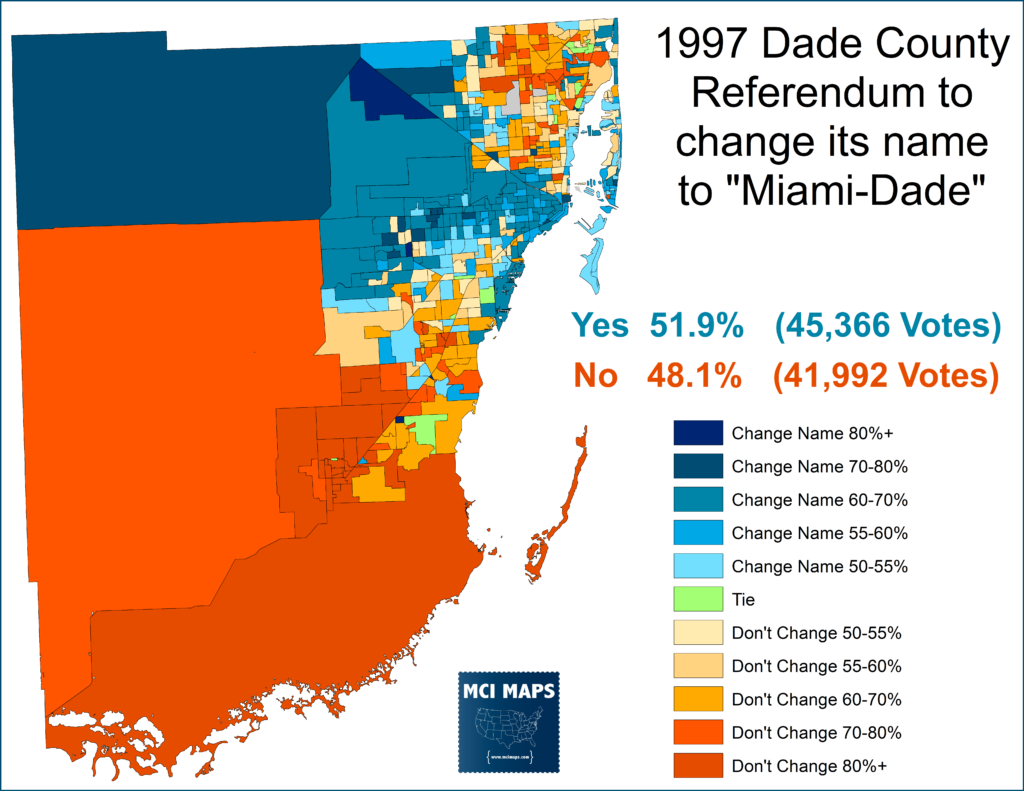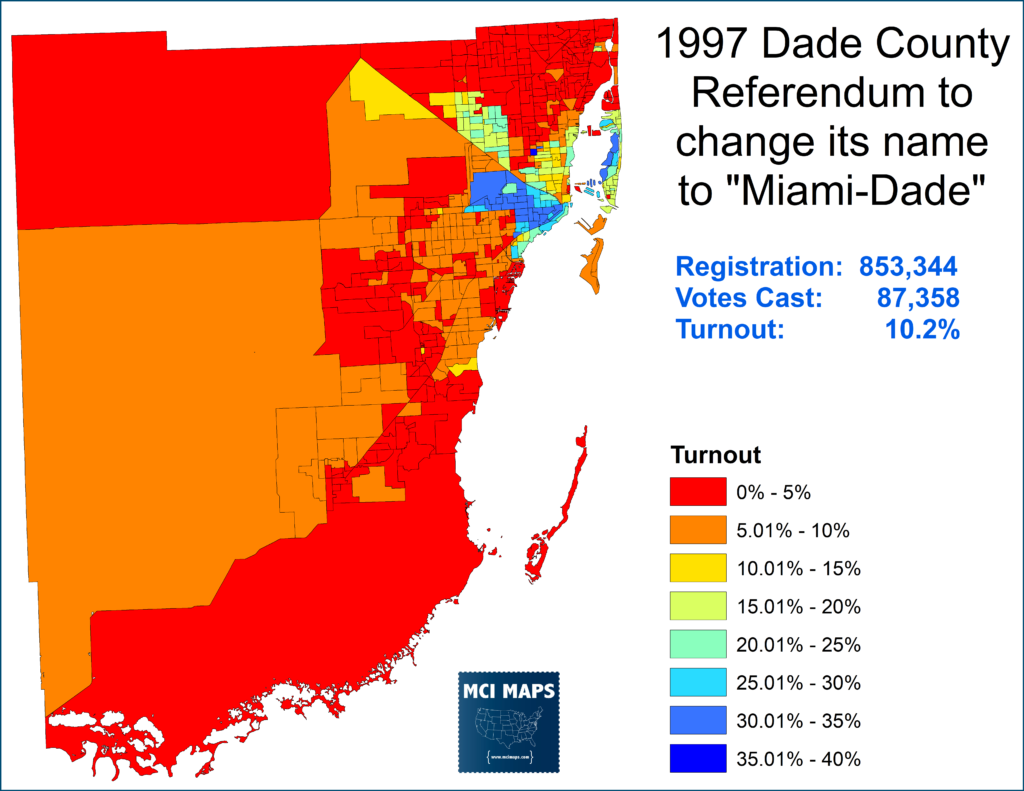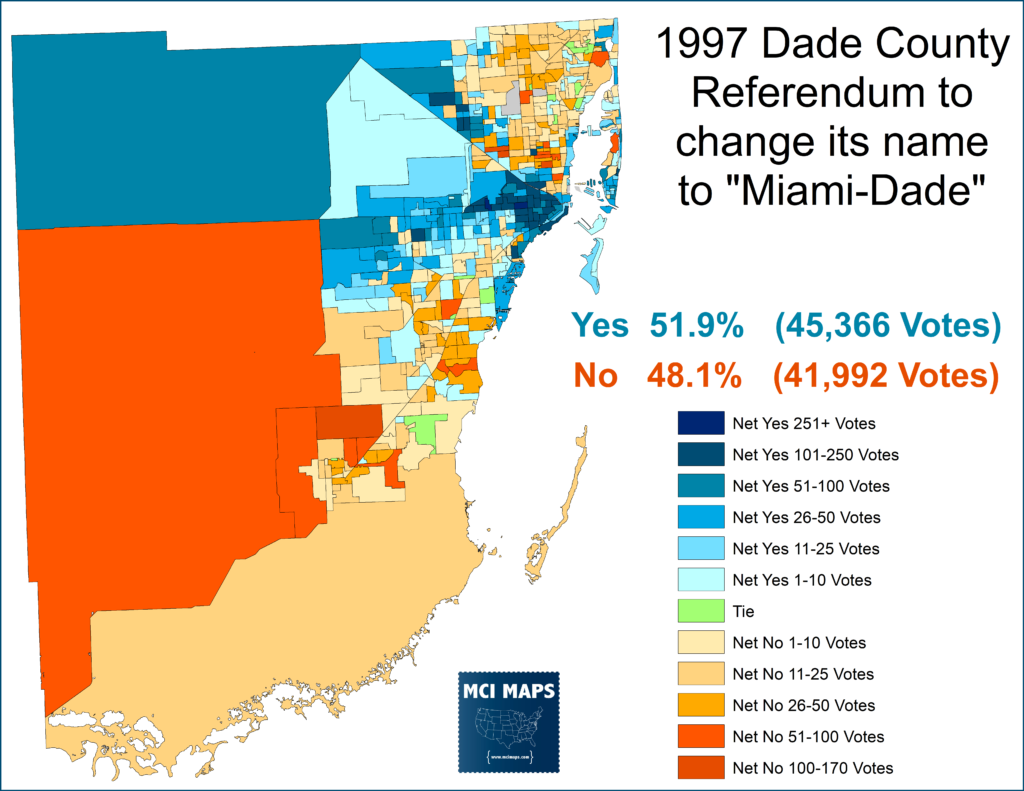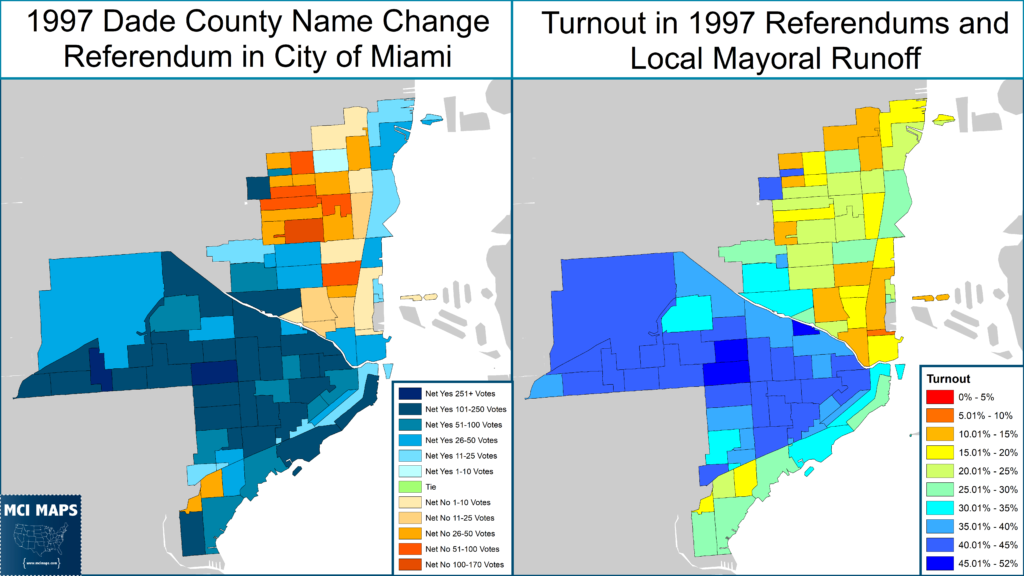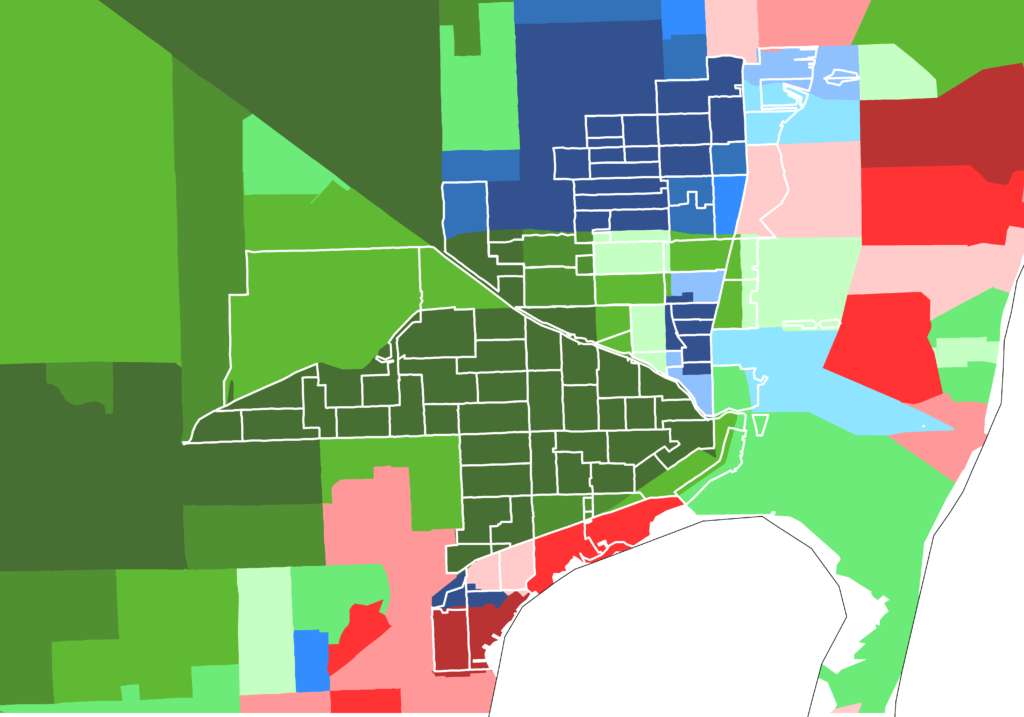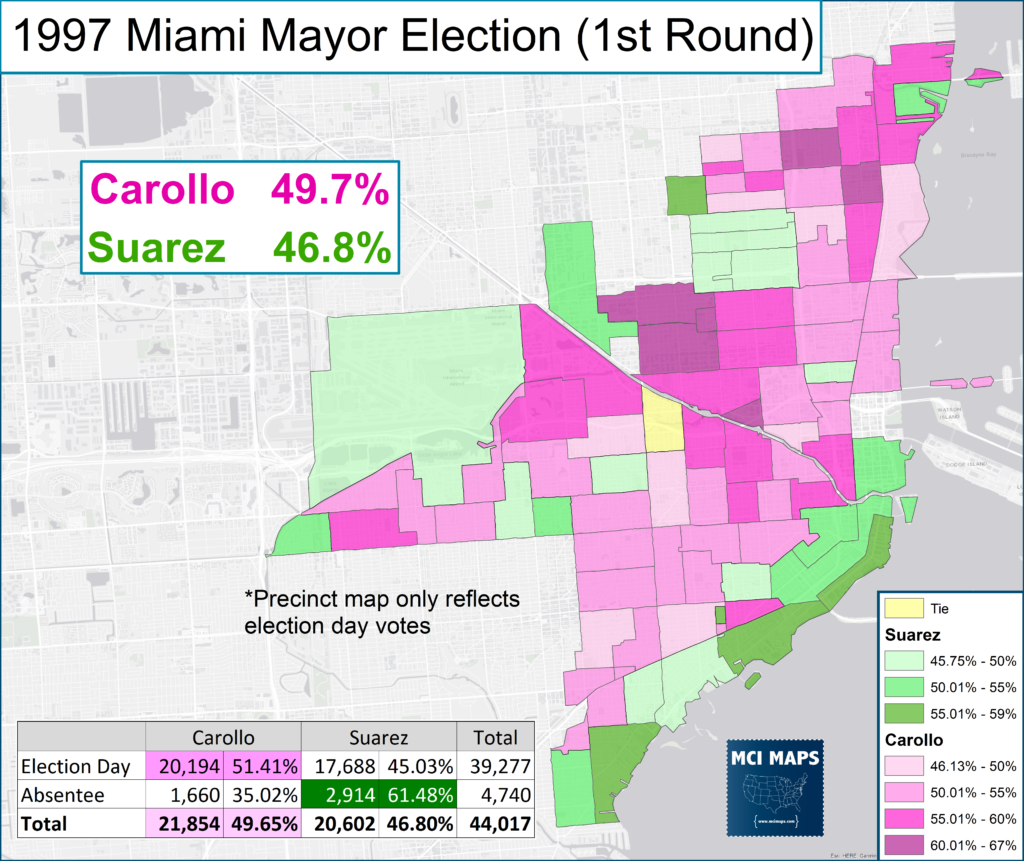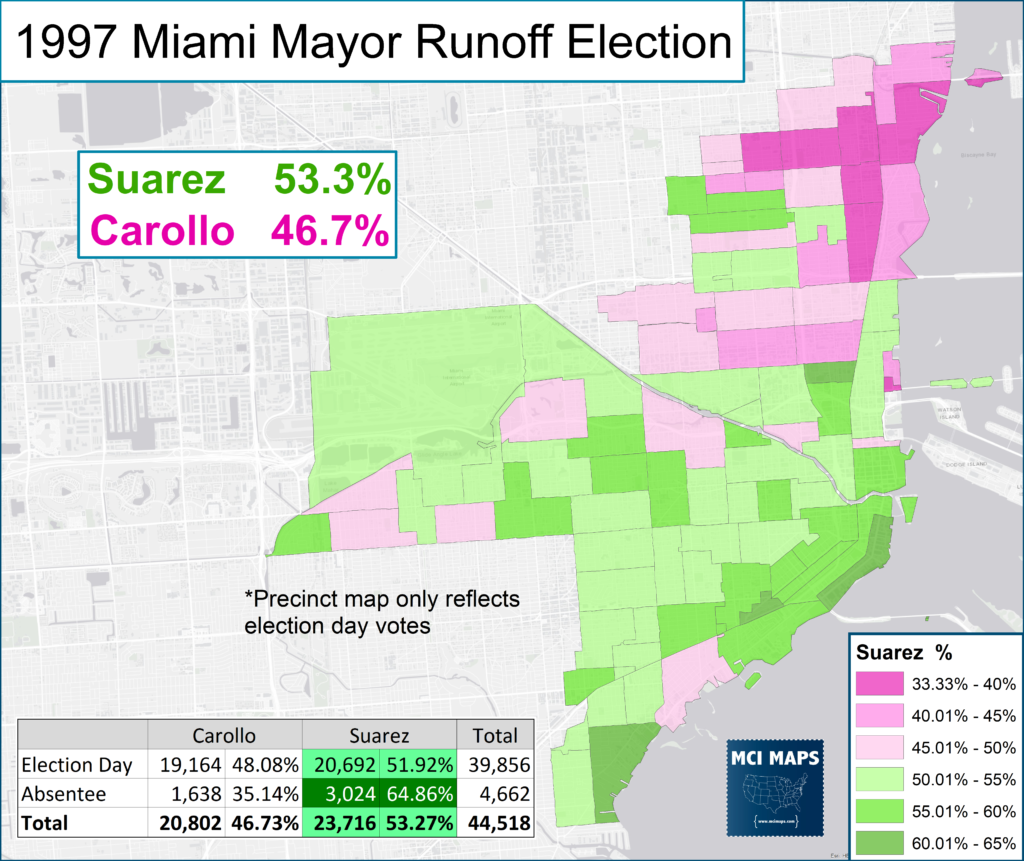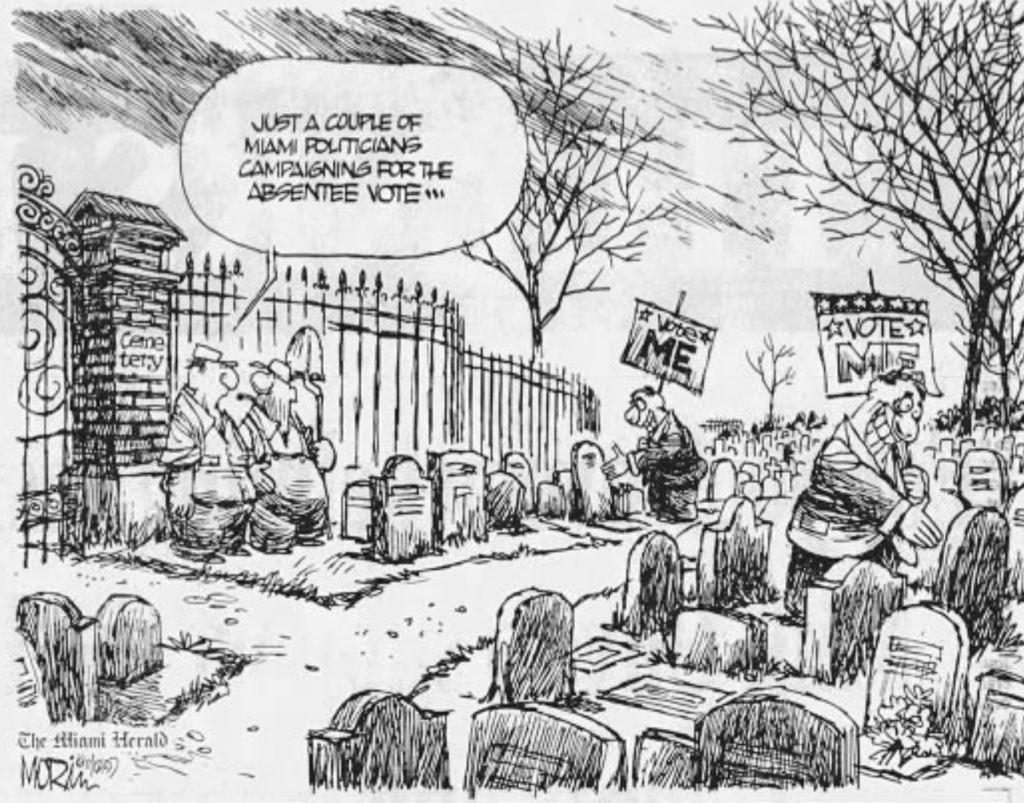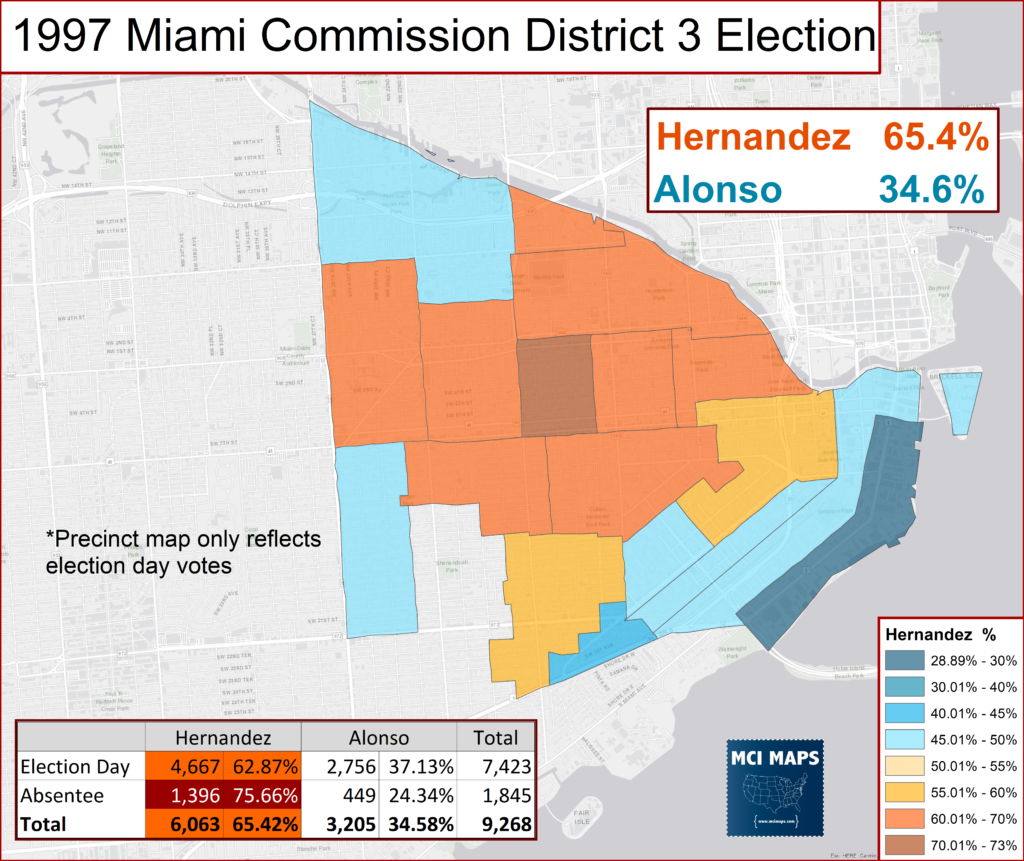A shocking piece of news. Last night, State Judge Ron Austy signed an order that invalidated a 1997 referendum that changed Dade County’s name to “Miami-Dade.” Austy struck down the referendum, saying it was illegitimated and not conducted under fair election practices. As a result, Miami-Dade’s name-change from 23 years ago has been reversed.
The ruling cited absentee ballot fraud that took place during the City of Miami Mayoral election, which occurred at the same time of the referendum. The mayoral election was famously invalidated for the fraud, but the referendum was unaffected until now. It can be sure that appeals will happen, but in the meantime, lets look at the backstory to the bizarre case.
The 1997 Referendum
Efforts to change the name of Dade county failed 6 times before success: 1958, 1963, 1976, 1984, and 1990. All referendum’s failed by landslide margins. The county was named after Francis Dade, a commander who was killed in a battle with Seminole residents. Since the 1950s, which saw growth in southeast Florida and Miami emerging as a international hub, there was a push to change the obscure name. The 1994 vote, which would have changed the name to “Metropolitan Miami-Dade County” failed by a 13%-87% margin. Voters had long showed little interest in the name change. However, as the 1990s went on and Miami grew in international reputation as a business and tourist hub, business and government leaders aimed for another chance to change the name. Many government leaders wanted to lure over industries, businesses wanted to attract investments, and the tourism industry wanted to attract more events. When Alex Penelas was elected county mayor in 1996, he made the name change a priority – believing adding “Miami” to the name would help him attract business and investment. Penelas was a dynamic politician for the time – a young Cuban democrat who was close with the business community of the county. His 1996 runoff victory over Arthur Teele, an environmentalist black republican (who was backing Bob Dole that year) is hands down one of the most unique electoral maps of the time.
With Penelas in the top job, the business community has a strong ally in the effort to change the name. Penelas and the business community planned for a referendum to coincide with the November 13th, 1997 runoffs for city races. The referendum would be listed along two other minor questions and the mayor and city council runoffs for Miami, Hialeah, and Miami Beach. The business communities raised just under $90,000 for a stealth campaign that largely ran ads in Hispanic and black radio. Major businesses like American Airlines and Carnival Cruise Lines each gave $10,000. The goal was a quiet campaign that pushed the idea in the short window before the election day. As a result, no major debate took place and there was no organized opposition campaign. In addition, the Miami Herald, which had argued against every past name-change, opted to support the measure in 1997; arguing a change could help, but at worst wouldn’t hurt.
When the results came in for the referendum, the name change had narrowly passed. By just a 4% margin, the county would change its name for the first time since statehood. The results were a shock to many voters, who didn’t even realize the referendum was happening. Voters, for the most part, seemed to shrug the change off, while the business community was thrilled. The lack of voter engagement can best be summed up by a Dade County courthouse employee saying “What do you mean the county’s name has changed? What are you talking about?” when asked by a reporter.
The measure passed in the city of Miami and along the Hispanic corridor that extends west. It had mixed results in the Hialeah area (where it narrowly passed) but failed in the northern black precincts and in the south end of the county.
Supporters of the change were expecting (and counting on) a low turnout electorate. They got their wish. Just 13% of voters showed up for the referendum. As the turnout data shows, the bulk of the voters were not there for the referendum, but for city runoff’s being held in Miami, Hialeah, and Miami-Beach.
While turnout was officially 13%, it was only 10% for the referendum, as many voters in the three cities didn’t even vote down ballot on the name change. Still, the turnout for the referendum itself is drastically higher in the cities than it is in the rest of the county.
When you look at the referendum by the three cities and the rest of the county – how it passed becomes very clearly. Each of the three cities had turnout between 30-35%. The rest of the county was just 6%! This is also the area where it failed. Most importantly, the referendum’s 5,000 vote margin in the city of Miami was larger than the 3,400 countywide margin. Without the higher turnout in the cities, the measure likely would have failed.

The absentee ballots, about 10% of the vote cast, are not broken down by their respective precinct, so I included them as a separate total. The name-change failed in absentee’s by almost 2-1. Half of these ballots came from Miami, though its unclear how the absentees would have broken down by each geographic area. However, there is alot more to be said about absentee ballots further into this article.
How one area of Miami won the referendum
A vote margin map further highlights how important Miami was – with its Hispanic core being a major source of net votes. The fact was that most NO precincts were low turnout. Even in Miami itself there was a turnout disparity. It’s mayoral runoff was between two prominent Cuban politicians. Turnout in the black precincts of the city were much lower. The big margins came from more predominantly Hispanic precincts.
Another way to highlight the importance of the Hispanic Miami precincts is to look at the margin’s by square mile (a type of density analysis). The Hispanic Miami precincts stand out from space – giving the YES camp a major block of votes to withstand losses elsewhere.
If we zoom in directly to the city itself, the southern half of the city (divided by the river) stands out in both margin and turnout overall.
The river is also a strong divider of race in the area. The region south of it are overwhelmingly Hispanic – often 70-80% plus. White voters dot the coastline and African-American and mixed neighborhoods exist further north. However, the city south of the river in a major Hispanic hub.
So as mentioned, the turnout in the Hispanic portion of the district had such strong turnout thanks to the Mayoral Runoff between two prominent Hispanic candidates. We need to talk about that election and the absentee scandal around it.
The Infamous 1997 Miami Mayoral Election
The Dade name-change referendum took place the same year as the most infamous mayoral election in the city of Miami. It stands as one of the biggest fraud scandals for the state in the modern era. It eventually led to a court case that saw the results overturned. This fraud-riddled election is likely why the name change referendum passed.
The Miami mayoral election was a major heavyweight fight. Incumbent Mayor Joe Carollo was being challenged by Xavier Suarez, who’d served as mayor until retiring in 1993. Three other candidates, none serious, were also running. The race was nasty and vicious; with Miami’s finances becoming a major focus. Carollo is a fierce and controversial politician who had lost re-election to the city council in 1987. Carollo made a comeback, winning a city council race in 1995 and then a special election for Mayor in 1996 when Incumbent Steve Clark died of cancer. Carollo had undergone an image rehabilitation in the 1990s, making amends with many black leaders after racist barbs in the 1980s and trying to reset his image as less combative and bombastic (that didn’t last). Carollo walked into the mayoral office in 1996, facing no real opponents, and immediately clashed with and fired the city manager, Cesar Idio. This firing, however, revealed a long history of corruption and debt with the city’s finances. The new manager uncovered over $68,000,000 in debt for the city. Idio would go on to be convicted of obstruction of justice relating to a kickback scheme. The reputation of the city was shattered. Its bonds became junk status and in December of 1996, Governor Lawton Chiles ordered the takeover of the city’s finances (at Mayor Carollo’s request). Suarez, who was not hit by the corruption scandal’s themselves (which also nabbed a commissioner), decried the state intervention and claimed Carollo was exaggerating the city’s problems. In September of 1997, just two months before the city elections, the residents voted to reject a petition-proposal to abolish the city itself. The proposal drew heated opposition from the city’s Cuban voters, who controlled government and saw it as a direct attack.
This drama set the stage for the November 4th Mayoral election. Suarez ran hard against Carollo, while the mayor used his stewardship as the justification for a full term in office. When the results came in, Carollo was just shy of the 50% to avoid a runoff. He’d actually secured the majority of election day ballots, but lost absentee’s almost 2-1.
As a result, a runoff would take place less than two weeks later, on November 13th. Suarez would go on to win that race by a fairly comfortable margin. This was the same day as the Dade county name-change referendum.
The runoff itself drove turnout for Miami. Had Carollo won outright on November 4th, Miami would have had nothing to show up for beside the name-change vote. The referendum itself was not a driver of votes – as demonstrated by the weak turnout in the non-Hispanic portions of Miami. The runoff (and first round) where largely contested in the Hispanic community and Spanish radio/literature. It was a clash of two prominent Cuban politicians and it resulted in Hispanics making up over 75% of the vote cast despite only being 50% of registered voters. It was thanks to that high turnout in Miami’s Hispanic corridor, which netted the YES side 5300 votes, that the name referendum was able to pass.
Absentee Ballot Corruption in Miami
Before the runoff for Miami mayor even took place, a major investigation was already brewing around the absentee ballots cast in the first round of voting. Reports began to emerge that volunteers and staffers with the Suarez campaign had engaged in absentee ballot fraud in order to secure their candidate a huge win – which forced the runoff. Ballots were cast from dead voters, from voters who insisted they never asked for a ballot, people out of the district, and people who were bribed to offer their vote. The emerging scandal, which resulted in its first arrest of a Suarez worker within days of the first round, was nothing really new for Dade. “Ballot brokers” – as they were often known, would get paid sometimes $30 per returned absentee ballot. The election for Miami mayor generated hundreds of thousands raised and spent by the two candidates – all for a low turnout race. Plenty of money was free for such payments.
Ballot broker scandals included calling in requests for ballots for older voters, then picking them up at the addresses and filling them out. The tricking of elderly voters could best be seen in a quote from a 103 year old Miami Beach resident who, according to records, had voted absentee: “I’m not on top of things….. I have a citizenship card. I think maybe I voted, I don’t know.” Plenty of forged signatures were also discovered. Such scandals led to an election in Hialeah being tossed out in 1993 and efforts to curtail the shady practices were falling short by this point. (Spoilers – much more serious reforms came years later in Florida, namely making payment for collection illegal). Several voters interviewed admitted they just turned in blank ballots to the brokers who offered to “take them off their hands.” A story out of Miami Beach’s Mayoral election showed candidates hiring ballot brokers who lived in the senior communities they would collect from. Many of these brokers, when questioned by the press about payment, would try to deny it despite campaign records showing it. The trick here was that brokers were trusted neighbors – and many voters told the press they trusted the man/woman to pick the right candidate. For the voters, it came off as a convenience.
Just a few days before the runoff, Florida Department of Law Enforcement served a subpoena to Alberto Russi, a 92 year old ballot broker for Suarez. Inside his home, which had seen multiple absentee ballot requests for the first round and all witnessed by him, was 100 absentee ballots set to be turned in for the runoff and 21 voter registration cards. Russi was like many ballot brokers, folks trying to get influence with city hall for things their worn-down communities needed. Russi, a Cuban exile, was not rich. He lived in a modest house with bars on its windows. Politicians like Suarez and Commissioner Humberto Hernandez would remember these loyal people. In the interview with Russi, he talks about helping Commissioner Hernandez’s secretary register at his neighbor’s house so that she could vote for her boss in the November 4th election. His next lines stand out – “This is illegal?” – or “I hope she doesn’t get in trouble. She is a nice girl and wanted to help out.” (The point I’m making here is Russi isn’t some mastermind villain).
Now, why am I talking about Russi? He was a mentor of Commissioner Hernandez – who had been elected in a 1996 special election. Hernandez, the son of a Bay of Pigs veteran, was a young and charismatic Cuban politician who had already been suspended from office for money laundering and bank fraud. His 1996 win was the last year of Miami holding at-large elections. His win against Richard Dunn meant no black commissioners remained in Miami, a first in 35 years. The ethnic split in the vote (which saw Dunn dominate the black and white vote and Hernandez dominate the Hispanic vote), coupled with Hernandez’s already poor reputation for ethics, resulted in the final move to single-member districts – which were set for the 1997 elections. Hernandez ran for the newly-created district that covered the 80%+ Hispanic “Little Havana” and got 65% of the vote in the November 4th election.
Hernandez, who hated Carollo for backing Dunn in the 1996 election, endorsed Suarez for the runoff. His and Suarez’s machines worked in tandem in the Little Havana region of the city and across the exile community. This drastically improved Suarez’s share of the Hispanic vote in the runoff. While the absentee investigation was already raging by the runoff, there was a similar share of ballots returned compared to the first round and they again dominated for Suarez. Hernandez would be a staunch Suarez ally on the council. However, he’d eventually be suspended from office again and serve jail time for his corruption scandals.
Even as Suarez was sworn into office, the investigation into the absentee fraud continued. In March of 1998, the circuit court THEW OUT the first round of voting, saying the absentee fraud was so severe it could not stand. Just a few days later, the appeals court of Florida restored Carollo as Mayor, arguing he would have won the first round of voting if not for the fraud. In the final eyes of the court, no runoff should have even taken place. The same runoff that drove the turnout the name-change referendum needed to win.
Judge’s Decision
Judge Austy’s ruling had two key points for why the referendum should be invalidated.
- The referendum was manipulated to take place in a time of low turnout and low interest
- The electoral fraud that took place in the largest city in the county tainted the process
Austy’s decision will likely be stayed pending appeal. Realistically a new referendum would likely pass now with little issue. We’ll have to see if the appeals court agree with the issues laid out in the ruling. You can read the full ruling here.

